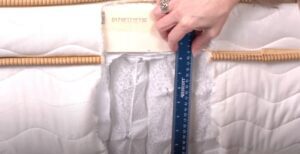Toxic Mattress Chemicals Breakdown
Disclosure: By clicking on the product links in this article, Mattress Nerd may receive a commission fee at no cost to you, the reader. Read full disclosure statement.
Mattress shopping can be exciting, but it can also be overwhelming. There are so many options out there, and it’s nearly impossible to tell which one is the best for your sleep needs. Plus, you need to worry about the safety of your mattress. After all, most human beings spend around one-third of their life asleep, so it’s absolutely vital that you know what’s in your mattress. It’s not enough to trust that because something is labeled as “natural” or “eco-friendly” that it’s actually safe for your sleep.
Natural mattresses typically contain fewer synthetic materials than a non-natural mattress, but they still contain some synthetics, and could potentially contain them in unhealthy amounts. Organic mattresses, on the other hand, contain no synthetic materials, which is definitely a better choice if you’re looking to limit harmful chemicals in your mattress. Finally, eco-friendly mattresses are more concerned with how the mattress affects the world rather than how it affects human beings. Some materials that break down easily and are good for the environment are not as good for people, so be sure to do your research when looking at mattresses labeled as “eco-friendly.”
If you’re already feeling overwhelmed, it’s okay. We’ve done the research and created this handy guide to help you avoid potentially dangerous chemicals, find organic mattresses that are good for your health, and explain the nitty-gritty of safe mattress buying.
Off-Gassing
One term that frequently pops up in discussions of mattresses and chemicals is “off-gassing.” This is the phenomenon that occurs when a mattress and its associated materials release volatile organic compounds (VOCs) into the air. These VOCs can include formaldehyde, toluene, chlorofluorocarbons (CFCs), benzene, trichloroethane, and perfluorocarbons, though each mattress is different and may release different chemicals.
Initial off-gassing can create a strong smell and may even give you a headache or make you feel dizzy at first, but all of these effects should fade within a few days or possibly a week or so. Off-gassing continues throughout the life of the mattress, but it will release very minimal amounts of VOCs after the initial off-gassing. How strong the off-gassing is at first depends largely on the materials the mattress is made with and how the mattress is delivered.
Popular bed-in-a-box mattresses typically have much stronger off-gassing because the mattress is rolled up and vacuum sealed, and when it is released, more chemicals are released with it. A mattress that arrives at your house out of a box likely did most of its off-gassing before getting to your house, and therefore will smell less and will release fewer fumes into your home.
Generally, off-gassing has not been found to be harmful to human beings in any lasting way, but research has shown that continual exposure to VOCs could potentially lead to increased risk of cancer, nervous system damage, and liver or kidney damage. Because of this potential risk, some people prefer a mattress with limited off-gassing. For more info, head over to our mattress off-gassing guide.
Chemicals You Do Not Want To Sleep On
PBDEs / Chemical Flame Retardants
What Is It?
Polybrominated diphenyl ethers, also known as PBDEs, were used for a long time as chemical flame retardants. Everything from construction materials to furniture padding was made with PBDEs to help protect them from fire hazards. At first, this sounds like a good thing, but PBDEs are actually very dangerous and have been banned in the United States and many other countries. Although new items cannot be produced using PBDEs, there are still plenty of old items in our houses and on the market that still contain this dangerous chemical.
Where Is It Found In a Mattress?
PBDEs used to be included in the foam part of the mattress, and could also sometimes be found in the mattress cover or topper. No newly manufactured mattress should be allowed to contain PBDEs at this point in time, but if you are buying your mattress used, or buying a very old model, be sure to do your research carefully.
What Are the Potential Dangers?
The reason PBDEs are so dangerous is that they don’t stay in your mattress. These chemicals are dissolved into other materials, and as a result, they can easily escape said materials and make their way into you and me. Once we absorb PBDEs, they remain in our tissue and they can continue to build up over a lifetime. When this happens, there can be a host of negative health effects. A study published in the Archives of Toxicology found that PBDEs are associated with thyroid, neurodevelopmental, and reproductive issues.
Propylene oxide and TDI
What Is It?
Propylene oxide and TDI (Toluene Diisocyanate) are chemicals used to create polyurethane foam and memory foam, which are popular mattress materials. Unfortunately, they are responsible for a large amount of off-gassing of VOCs, and many people may want to avoid them.
Where Is It Found In a Mattress?
Propylene oxide and TDI are found in polyurethane foam and memory foam, which is present in nearly all mattresses on the market today. Most mattresses now are either entirely memory foam or hybrid mattresses containing memory foam and coils. Even some innerspring mattresses contain foam made of propylene oxide and TDI. If you’re looking to avoid these chemicals, you’ll need to research very carefully.
What Are the Potential Dangers?
The reason we suggest avoiding these chemicals, despite their popularity, is due to recommendations from the Centers for Disease Control (CDC). The CDC has announced that both propylene oxide and TDI are associated with increased tumor risk in mice and rats. Although these findings have not yet been replicated in humans, the CDC recommends that we limit our exposure to both chemicals. Since we spend so much time on our mattresses, it is not recommended to use a mattress containing these chemicals.
Toluene
What Is It?
Toluene is a clear liquid chemical associated with the distinctive smell of paint and paint thinner. It can enter the human body through the air, through water, or even through the soil. Single, low exposure to toluene is unlikely to be harmful, but repeated exposure could be associated with health concerns.
Where Is It Found In a Mattress?
Toluene is used in foams present in most mattresses, just like TDI, except most companies use TDI rather than toluene now. This is because toluene has been found to be even more harmful to people’s health than TDI.
What Are the Potential Dangers?
According to the CDC’s Agency for Toxic Substances and Disease Registry, repeated, long-term, heavy exposure to toluene can result in serious effects, like seizures, cognitive impairment, hearing loss, and developmental delays in children or babies born to women exposed to high levels of toluene during pregnancy.
Dimethylformamide
What Is It?
Dimethylformamide (DMF) is a clear chemical with the faint smell of ammonia that is commonly used in chemical manufacturing, acrylic fiber spinning, and more. It has been banned in the EU but is not yet banned in the United States.
Where Is It Found In a Mattress?
DMF is not actually present in mattresses as a finished product, but it is used in the manufacturing process and could be released into the air as a VOC.
What Are the Potential Dangers?
According to the CDC, DMF causes the most damage when absorbed through the skin. When this happens, DMF can cause liver damage and preliminary studies show that it may also cause cancer. However, DMF is not absorbed through the skin with a mattress because it is only released into the air as a VOC, but it can also be inhaled. When inhaled in small amounts, it is less likely to cause liver damage, but if you want to be safe, it may be best to look for a mattress without DMF.
Benzene
What Is It?
Benzene is a chemical commonly used in the creation of plastics, dyes, synthetic fibers, and more. It is one of the most common VOCs typically released from mattresses through off-gassing.
Where Is It Found In a Mattress?
Benzene can be found in polyurethane foams used in many types of mattresses, including memory foam and some hybrids or innerspring mattresses. It is typically released through off-gassing.
What Are the Potential Dangers?
The CDC’s guide to benzene says that it causes damage by preventing the cells from working as they are supposed to. If you are exposed to small amounts for a short period of time, this causes short-term dizziness or headaches, but long-term exposure can lead to anemia or immune system dysfunction.
Polyols
What Is It?
Polyols are chemicals used to create polyurethane foam, which, as we’ve mentioned, is a major component of most modern mattresses. Polyols are a family of chemicals and they can be made differently to reduce potential harm. For instance, some polyols are made from vegetable oils. Be sure to do your research carefully. In most cases, even mattresses that boast these vegetable oil polyols only use them in small amounts, and the rest are the more dangerous kind.
Where Is It Found In a Mattress?
You can find polyols in any mattress that contains polyurethane foam, which typically includes memory foam mattresses, many hybrid mattresses, and even some innerspring mattresses. The polyols are found in the polyurethane foam, and they play a major role in the release of VOCs.
What Are the Potential Dangers?
Typically, those who experience excessive exposure to polyols experience allergic-type reactions. You may notice dizziness, headaches, nausea, and trouble concentrating. Although these effects aren’t as severe as some of the effects caused by other chemicals on this list, we sleep on our mattress every night and having a headache every single day would get old very quickly.
Organic / Non-Toxic Mattress Labels You Can Trust
Unfortunately, many mattresses do contain many of these harmful chemicals, so what are you supposed to do? How do you find a mattress that won’t be detrimental to your health? The best strategy is to look for trusted certifications from independent companies that seek to identify safe products for your home, like the ones below.
Global Organic Textile Standard (GOTS)
- According to their website, the Global Organic Textile Standard (GOTS) is “the world’s leading processing standard for textiles made from organic fibers.” It defines what makes products considered safe according to several environmental and social factors. In order to qualify for this standard, a textile product must be made of at least 70% organic fibers, and 30% of non-organic fibers still have to meet stringent environmental and toxicological standards. To receive certification for GOTS, an independent evaluator must come to do an inspection to approve your textile product.
Oeko-Tex Standard 100
- The Oeko-Tex Standard 100 provides a slightly more comprehensive certification than the GOTS. Any item with this certification has been inspected by an independent Oeko-Tex partner and every component is free from harmful substances. Best of all, the Oeko-Tex Standard 100 looks out for harmful chemicals, even if they haven’t been regulated by government bodies yet.
Greenguard Gold
- The goal of Greenguard is to help consumers identify products with low emissions, to improve the air quality of your home. Their Gold certification is the most stringent one that they offer because it aims to protect more vulnerable populations, like children and those with allergies and sensitivities. Specifically, it aims to limit VOCs, and a product can only receive a Greenguard Gold certification if it has very low amounts of VOCs.
See: Guide To Natural, Non-Toxic Bedroom Products
Making the Switch to a Non-Toxic Mattress
If you tend to be very sensitive to various chemicals, or if you’ve noticed that you tend to get a headache on days when you’re cooped up in your house, you might be ready to make the switch to a non-toxic mattress. To get you started on your research, we’ve put together some resources on alternative materials and organic mattresses that are better for your health.
Non-Toxic Alternative Materials To Look For
- Organic cotton: Organic cotton is good for both you and the environment. From planting to harvesting to finishing, organic cotton is created without any chemicals that are harmful to the environment or to the humans who use the finished products. When shopping for a non-toxic mattress, be sure to look for one made with organic cotton rather than non-organic cotton.
- Wool: Wool is naturally a very organic, non-toxic material. It is non-allergenic, renewable, and naturally flame-retardant, which means it doesn’t need to be treated with the harmful PBDEs we mentioned above. Mattresses made with wool are generally much safer than other options.
Buy a Mattress Cover
- If you’ve recently bought a new mattress with significant off-gassing and you can’t stand the smell, try buying an organic mattress cover. Unfortunately, it can’t protect you from the harmful long-term effects of the VOCs, but it can help reduce the smell, which in turn could reduce your headaches or dizziness.
Buy an Organic Mattress
- The best way to be sure that your mattress is good for both you and the environment is to buy a new, completely organic mattress. The best organic mattresses are typically hybrids that include latex or a full-latex mattress because all-natural latex is a great organic material for the environment, your health, and your sleep quality. Latex mattresses are breathable, cool, and supportive, offering great pressure relief and spine alignment for all kinds of sleepers. The best latex mattresses are made naturally rather than synthetically, and they’re good for the environment and your health as well.


